Tom Allegretti
-
- Safe Operations, Proven Results Marine News, Apr 2013 #18
A Response to “The Articulated Tug Barge (ATB) Quandary”
The recent editorial (MarineNews February edition) by Jeff Cowan entitled “The Articulated Tug Barge (ATB) Quandary” raised more than a few eyebrows here at the American Waterways Operators (AWO) and among AWO members who operate ATBs. Mr. Cowan has it backwards: far from being unsafe, ATBs in fact represent a significant advancement in safety in the coastal tugboat and barge industry and have a long history of safe operation. Mr. Cowan’s piece also contained several factual errors and is based on the flawed premise that the regulatory standards for tankers should be applied rigidly to ATBs despite the differences in vessel characteristics. We would like to set the record straight.
First, while Mr. Cowan suggests that ATBs are a poor substitute for tankers, we have never heard industry experts argue that ATBs are, or should be, replacements for tankers. Rather, ATBs are replacements for towed barges, and as such provide substantial improvements in terms of safety, reliability, effectiveness, accommodation and comfort. Even so, one could nonetheless make the case that an ATB is as safe, or, in some cases safer, than a tanker. Consider a few key areas.
Vessel Design and Technology
Proven engineered systems for connecting the tug in the notch to the barge have been successfully deployed in the U.S. coastal trades since 1986. Mr. Cowan suggests that ATBs are prone to coming out of the notch in heavy weather, but in fact the opposite is true. They are designed to stay in the notch as a safety feature. In some coastal areas, including those around the Columbia River Bar, ATBs regularly operate safely in 15-25 foot seas or more.
Additionally, an ATB by design has more redundant systems than a tanker. All ATBs have two propulsion plants that operate independently, whereas all but six U.S. coastal tankers have single propulsion systems. Additionally, ATBs have two propellers and two rudders compared to the vast majority of ships, which only have one. ATBs are built to the same ABS standards as tankers and comply with all applicable IMO regulations.
Crewing and Safety Management
Tankers in the 330,000-barrel range typically have a 21-person crew that includes three stewards, compared with 14 on a similar-sized ATB, counting the cook. The difference in the number of personnel on the vessel is often made up with by larger shore-based maintenance crews. Tankers typically have nine officers compared with eight for a similarly sized ATB. There is one fewer on an ATB because there is less administrative work required of the master. As for watchstanding during cargo operations, a tanker typically has one deck officer and two able-bodied seamen (ABs), whereas a comparably sized ATB has one deck officer, one AB/Tankerman and one utility crew member. Several ATB operators don’t just use ABs, but rather specially trained AB/Tankermen. These individuals are full persons-in-charge (PICs) and can, if needed, be in charge of oil transfer operations.
ATBs are manned to comply with STCW 95 requirements and all crew members work within the 12-hour rule. The main difference in manning between tankers and ATBs is in the food preparation department and the extra hands used for on-board maintenance. Under the ATB operating model, some of the maintenance is performed by shore-based contractors. This eliminates the need to do maintenance while underway, which at times can be unsafe for crews to perform. The use of computer-based maintenance systems like ABS Nautical Systems 5 also helps to manage shore-based maintenance. Several ATB operators use this technology, in close partnership with ABS, to document maintenance and inspections.
To suggest that self-propelled ships with larger crews are inherently safer than ATBs is simply wrong. The fact is that ATBs have never had a significant accident, while the Cosco Busan (a container ship) and the Exxon Valdez referenced by Mr. Cowan, were both ships with large crews that had major accidents. Contributing to the record of safe ATB operations are major industry improvements in safety management systems, including the AWO Responsible Carrier Program, the ISM Code, the Tanker Management and Self Assessment (TMSA) office audits and Ship Inspection Report (SIRE) customer vessel audits. These systems are subject to rigorous internal and external audits. While Mr. Cowan suggests that ATBs do not carry the personnel necessary to successfully implement a safety management system, the opposite is actually true. The fact that companies operating ATBs have enthusiastically embraced safety management systems is a major reason why the industry is able to transport millions of gallons of oil each year safely, securely and efficiently.
Regulatory Compliance
It is important to note that several AWO member companies operate ATBs that travel to foreign destinations that are more than 200 miles offshore. These vessels are compliant with STCW 95 requirements and will adhere to the Maritime Labor Convention 2006 when fully implemented. These vessels also comply with International Ship and Port Security Code requirements and have approved security plans on all vessels.
Moreover, contrary to Mr. Cowan’s commentary, oil spill prevention regulations do not differ between tankers and ATBs. Tanker and ATB owner/operators use the same vessel response plans. And, while Mr. Cowan asserts that there is the potential for a spill of up to 400,000 barrels from an ATB, that is not only impossible (there are no 400,000 barrel ATBs), but also unlikely given the many layers of safety built into their operation.
The bottom line is that an ATB is no more likely to be involved in an accident than a tanker, and it is disingenuous to suggest otherwise. Our member companies take great pride in keeping their crews, their vessels, their cargo, and the waters upon which they operate safe and secure. Our industry will continue to advance this culture of safety as it moves the cargo upon which this nation depends.
(As published in the April 2013 edition of Marine News - www.marinelink.com)
-
- It's Time for a Towing Vessel Inspection Rule Marine News, Oct 2013 #17
inspection rules are the missing link in a journey of a continuous improvement that began more than 20 years ago. The Coast Guard, Congress, and our customers have all been active partners in that journey, encouraging and demanding that the industry strive daily to achieve the goal of zero harm to human
-
- EPA’s SmartWay Initiative Makes Way on the Water Marine News, Mar 2015 #36
program’s benefits and encouraging their participation as SmartWay Partners. “This program is a natural fit for AWO and our member companies,” said Tom Allegretti, AWO’s President & CEO. “Water transportation is inherently the nation’s safest and most environmentally-friendly way of moving commerce. More
-
- Subchapter M Casts Off Marine News, Oct 2018 #30
release AWO welcomed and highlighted Sub M’s startup: “The implementation of Subchapter M is a milestone to be celebrated,” said AWO President & CEO Tom Allegretti. “This is a tremendous achievement, and while it is far from the end of our industry’s safety journey, it is undoubtedly a critical milestone on
-
- Vessel Inspections: It's All About Safety Marine News, Jan 2020 #28
the worlds of police and keeping situations under control, can certainly be applied here. Indeed, the phrase found its way into remarks delivered by Tom Allegretti, the outgoing President and Chief Executive Officer of the American Waterway Operators (AWO), a trade association for the workboat and towing and
-
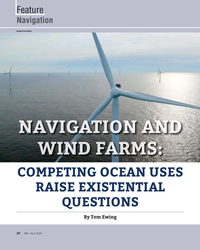 )
April 2024 - Marine News page: 20
)
April 2024 - Marine News page: 20Feature Navigation South Fork Wind COMPETING OCEAN USES RAISE EXISTENTIAL QUESTIONS By Tom Ewing 20 | MN April 2024
-
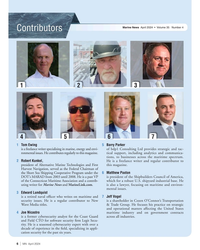 )
April 2024 - Marine News page: 6
)
April 2024 - Marine News page: 6Marine News April 2024 • Volume 35 Number 4 Contributors 1 2 3 5 4 6 7 1 Tom Ewing 5 Barry Parker is a freelance writer specializing in marine, energy and envi- of bdp1 Consulting Ltd provides strategic and tac- ronmental issues. He contributes regularly to this magazine. tical support, including
-
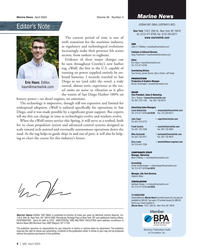 )
April 2024 - Marine News page: 4
)
April 2024 - Marine News page: 4Crowley’s new harbor Tel: 212-477-6700 tug, eWolf, the ? rst in the U.S. capable of Contributing Writers running on power supplied entirely by on- Tom Ewing, James Kearns, Barry Parker, Jeff Vogel board batteries. I recently traveled to San PRODUCTION Production & Graphics Manager Diego to
-
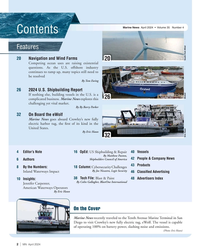 )
April 2024 - Marine News page: 2
)
April 2024 - Marine News page: 2Competing ocean uses are raising existential questions. As the U.S. offshore industry continues to ramp up, many topics still need to be resolved By Tom Ewing 26 2024 U.S. Shipbuilding Report If nothing else, building vessels in the U.S. is a 26 complicated business. Marine News explores this challenging
-
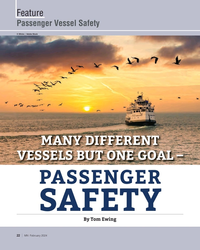 )
February 2024 - Marine News page: 22
)
February 2024 - Marine News page: 22Feature Passenger Vessel Safety © Olivier / Adobe Stock MANY DIFFERENT VESSELS BUT ONE GOAL – PASSENGER SAFETY By Tom Ewing 22 | MN February 2024
-
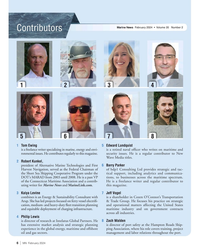 )
February 2024 - Marine News page: 6
)
February 2024 - Marine News page: 6Marine News February 2024 • Volume 35 Number 2 Contributors 3 1 24 6 5 7 8 1 Tom Ewing 5 Edward Lundquist is a freelance writer specializing in marine, energy and envi- is a retired naval of? cer who writes on maritime and ronmental issues. He contributes regularly to this magazine. security
-
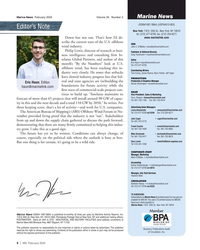 )
February 2024 - Marine News page: 4
)
February 2024 - Marine News page: 4“By the Numbers” look at U.S. Tel: 212-477-6700 offshore wind, has been tracking this in- Contributing Writers dustry very closely. He notes that setbacks Tom Ewing, James Kearns, Barry Parker, Jeff Vogel have slowed industry progress but that fed- PRODUCTION Production & Graphics Manager eral and
-
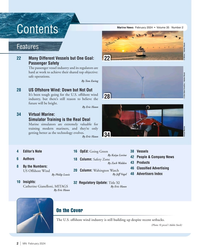 )
February 2024 - Marine News page: 2
)
February 2024 - Marine News page: 2Goal: 22 Passenger Safety The passenger vessel industry and its regulators are hard at work to achieve their shared top objective: safe operations. By Tom Ewing 28 US Offshore Wind: Down but Not Out It’s been tough going for the U.S. offshore wind 28 industry, but there’s still reason to believe the
-
 )
January 2024 - Marine Technology Reporter page: 31
)
January 2024 - Marine Technology Reporter page: 31at their mid-life point rather than module that plants itself on the bot- in Charleson, S.C. Likewise USS San incur the expense of the costly mid-life tom; the power and sensing modules; Franscisco was decommissioned in refueling. San Francisco was in com- and the business end, which is a Mark 2022
-
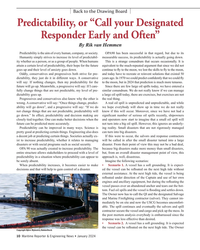 )
January 2024 - Maritime Reporter and Engineering News page: 10
)
January 2024 - Maritime Reporter and Engineering News page: 10Captain and use of her own engines and ancillary equipment, but during the re? oating the vessel passes over an abandoned anchor and tears out the bot- tom. Fuel oil spills and the vessel is ? ooding and settles down. The Owner now has to call the QI and the designated Salvage and Marine Fire? ghting
-
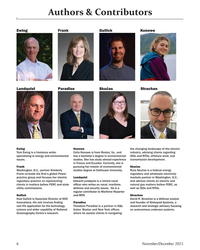 )
November 2023 - Marine Technology Reporter page: 6
)
November 2023 - Marine Technology Reporter page: 6Authors & Contributors Frank Ewing Gullick Konowe Skucas Lundquist Paradise Strachan Ewing Konowe the changing landscape of the electric Tom Ewing is a freelance writer Celia Konowe is from Reston, Va., and industry, advising clients regarding specializing in energy and environmental has a bachelor’s
-
 )
December 2023 - Maritime Reporter and Engineering News page: 24
)
December 2023 - Maritime Reporter and Engineering News page: 24speed by 10%, it would reduce underwater radiated noise by 40%, but nothing’s ever that simple. By Wendy Laursen Photo credits: © Jifmar Group Library / Tom Van Oossanen and AYRO 24 Maritime Reporter & Engineering News • December 2023 MR #12 (18-33).indd 24 12/5/2023 12:29:05 P
-
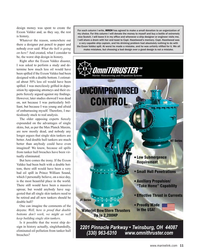 )
December 2023 - Maritime Reporter and Engineering News page: 11
)
December 2023 - Maritime Reporter and Engineering News page: 11disaster, I was asked to perform a study and de- termine how much less oil would have been spilled if the Exxon Valdez had been designed with a double bottom. I estimat- ed about 50% less oil would have been spilled. I was mercilessly grilled in depo- sition by opposing attorneys and their ex- perts ? ercely
-
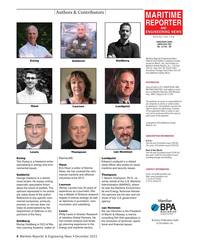 )
December 2023 - Maritime Reporter and Engineering News page: 4
)
December 2023 - Maritime Reporter and Engineering News page: 4van Hemmen One full year (9 printed issues) $140.00; two years $180.00 (18 printed issues) including postage and handling. Ewing MarineLMS. Lundquist Tom Ewing is a freelance writer Edward Lundquist is a retired specializing in energy and envi- Haun naval of? cer who writes on naval, ronmental issues
-
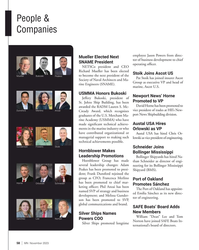 )
November 2023 - Marine News page: 58
)
November 2023 - Marine News page: 58been promoted to SVP, tor of engineering. global communications and brand. SAFE Boats’ Board Adds New Members Silver Ships Names William “Dean” Lee and Tom Sánchez Lee Norton Powers COO Silver Ships promoted longtime Norton have joined SAFE Boats In- ternational’s board of directors. 58 | MN November
-
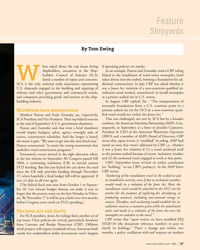 )
November 2023 - Marine News page: 37
)
November 2023 - Marine News page: 37Feature Shipyards By Tom Ewing hen asked about the top issues facing if operating policies are murky. shipbuilders, executives at the Ship- As an example, Paxton and Zorensky cited a CBP ruling builders Council of America (SCA) linked to the installation of wind tower monopiles (steel W listed a number
-
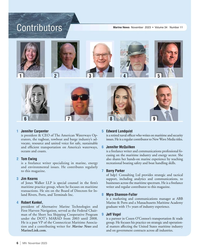 )
November 2023 - Marine News page: 6
)
November 2023 - Marine News page: 6McQuilken oceans and coasts. is a freelance writer and communications professional fo- cusing on the maritime industry and energy sector. She 2 Tom Ewing also shares her hands-on marine experience by teaching is a freelance writer specializing in marine, energy recreational boating safety and
-
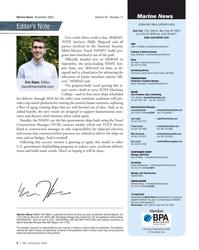 )
November 2023 - Marine News page: 4
)
November 2023 - Marine News page: 4series-leading NSMV, Em- Tel: 212-477-6700 pire State, was “delivered on time, as de- Contributing Writers signed and at a ? xed price for advancing the Tom Ewing, James Kearns, Barry Parker, Jeff Vogel education of future merchant marine of? - PRODUCTION Production & Graphics Manager cers,” MARAD
-
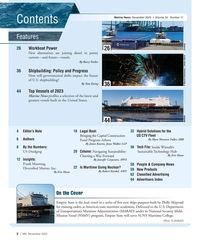 )
November 2023 - Marine News page: 2
)
November 2023 - Marine News page: 2future—vessels. By Barry Parker 36 Shipbuilding: Policy and Progress How will governmental shifts impact the future of U.S. shipbuilding? By Tom Ewing 36 44 Top Vessels of 2023 Marine News pro? les a selection of the latest and greatest vessels built in the United States. MARAD © Maxim Khalansky
-
![MR Nov-23#36 seen as an impediment “He [Tom Crowley] knows the importance](https://images.marinelink.com/images/magazines/w200h250c/MaritimeReporter-202311-page38.png) )
November 2023 - Maritime Reporter and Engineering News page: 36
)
November 2023 - Maritime Reporter and Engineering News page: 36decades, as traditional maritime of the company plus the data strategy and the digital journey.” mindset has, at times, been seen as an impediment “He [Tom Crowley] knows the importance of technology; Eto achieving next-level ef? ciency. we don't have to convince him,” said Graziuso, noting that’s Enter
-
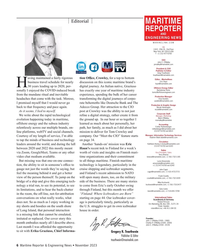 )
November 2023 - Maritime Reporter and Engineering News page: 6
)
November 2023 - Maritime Reporter and Engineering News page: 6.com President & COO Publisher & Editor Greg Trauthwein [email protected] aving maintained a fairly rigorous tion Of? ce, Crowley, for a top to bottom Editor - MarineNews Eric Haun business travel schedule for nearly discussion on this iconic maritime brand’s [email protected] H30 years leading
-
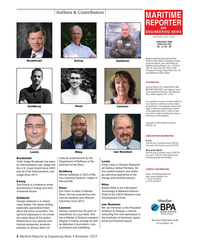 )
November 2023 - Maritime Reporter and Engineering News page: 4
)
November 2023 - Maritime Reporter and Engineering News page: 4in the Web: www.marinelink.com rine Learning Systems, maker of energy and maritime sectors. t: (212) 477-6700 f: (212) 254-6271 Ewing MarineLMS. Tom Ewing is a freelance writer Riley specializing in energy and envi- Haun Robert Riley is the Information ronmental issues. Eric Haun is editor of
-
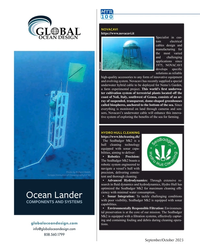 )
September 2023 - Marine Technology Reporter page: 74
)
September 2023 - Marine Technology Reporter page: 74MTR 100 NOVACAVI https://www.novacavi.it Specialist in cus- tom electrical cables design and manufacturing for the most varied and challenging applications since 1975, NOVACAVI develops speci? c Novacavi solutions as reliable high-quality accessories to any form of innovative equipment and
-
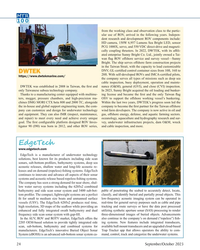 )
September 2023 - Marine Technology Reporter page: 24
)
September 2023 - Marine Technology Reporter page: 24offshore service and survey vessel—Sunny Bright. The ship serves offshore farm construction projects in the Taiwan Strait, with the capacity to load customizable DNV, GL-certi? ed control container sizes from 10ft, 16ft to DWTEK 20ft. With self-developed ROVs and IMCA-certi? ed pilots, https://www.dwtekmarin
